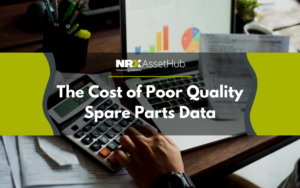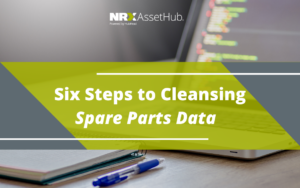There are many benefits of implementing a standard for your spare parts data, and before an EAM migration presents an ideal opportunity to cleanse your materials data and standardize your spare parts data. This ensures that your new EAM system is set up to support efficient maintenance operations and efficient procurement. As well, when performing an EAM migration you are already required to lift your data from your current system. Cleansing your materials data optimizes the spare parts data you migrate over into your new EAM and ensures it is accurate and reliable so that maintenance technicians can locate the correct materials and tell all your materials apart.
The following list of steps provide a glimpse into the scope of a materials cleansing project.

Step 1: Set Up
A careful analysis of your existing spare parts data is required before you start your materials cleanse.
You should determine:
- What low-quality source data is costing you the most?
- What tasks should take priority?
- How are you going to report on your progress, and what will be your KPIs?
Answering these questions helps you determine the best processes and tools to use as you complete your data cleanse.
Step 2: Build a Dictionary
Before you can begin cleansing your spare parts data, you may need to determine what naming conventions should be adopted so that all your spare parts can be easily identified according to a uniform naming system. This may mean developing best practices for creating abbreviations, classifications, or descriptions of spare parts, or later creating a rule book to help maintenance technicians understand your dictionary.
Step 3: Set Your Standards
Like a dictionary, standardizing your materials data means adhering to a uniform set of conventions for your spare parts data, such as names and attributes, as well as other information such as units of measurement or research sources.

Step 4: Cleanse Your Data
Cleansing your data comes after you have established your new dictionary and standards, and it is most likely the lengthiest step in a materials cleansing project. This involves carefully combing through your current spare parts data and optimizing it by resolving missing or ambiguous descriptions or attributes, linking spare parts to their parent equipment, and deciding what plant-specific information should be kept and what should be discarded.
Step 5: Review Your Data
It is critical to ensure that none of your low-quality data remains unchanged after a cleansing project.
An internal team or external consultants should conduct a quality assurance check to verify that the spare parts data meets an acceptable level of accuracy and completeness before it can be loaded into your new EAM system.
Step 6: Load Your Data into Your EAM System
Finally, once you have verified that your materials data is cleansed and ready, begin the process of migrating it into your new EAM system.
Step 7: Keep Your Data Clean
Good spare parts management leads to good spare parts data, so consistently using the best practices for effectively managing your spare parts guarantees high-quality materials data long term. Some of these best practices include training, keeping up with your standards and ensuring they are implemented consistently, and implementing a master data governance (MDG) solution for materials.
Consider Completing a Materials Cleanse and Standardizing Your Spare Parts Data
NRX solutions, powered by HubHead Corp., provides asset-intensive businesses with world-class software for visualizing, building, editing, organizing, governing, and sustaining high-quality spare parts data for their EAM and CMMS systems. If you would like to learn more about how our solutions can help you optimize your spare parts data for your new EAM system, book a demo, and our team would be happy to help you!
The Cost of Poor Quality Spare Parts Data
Optimizing Spare Parts Management
What Could Go Wrong With An EAM Migration?
Share this article




